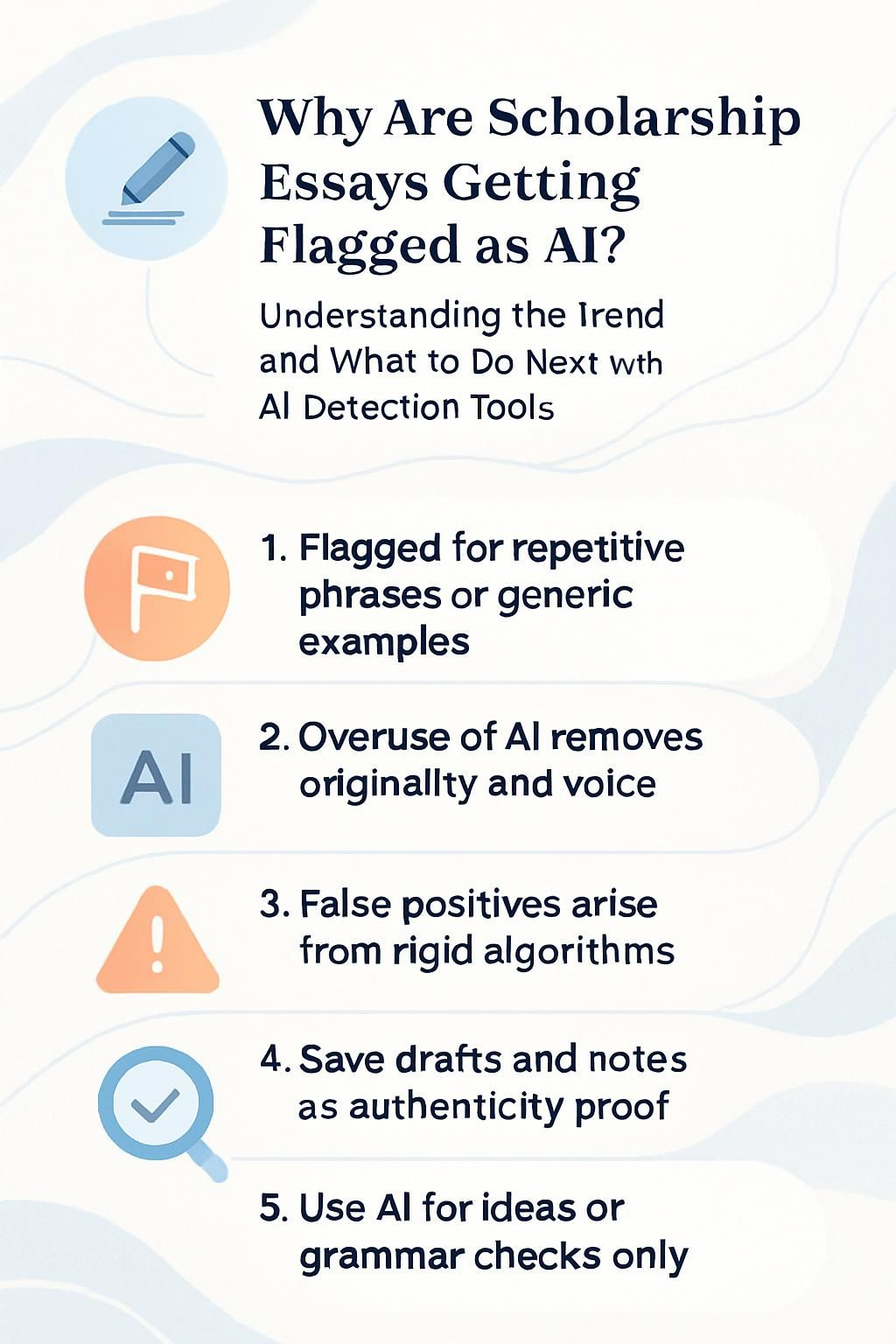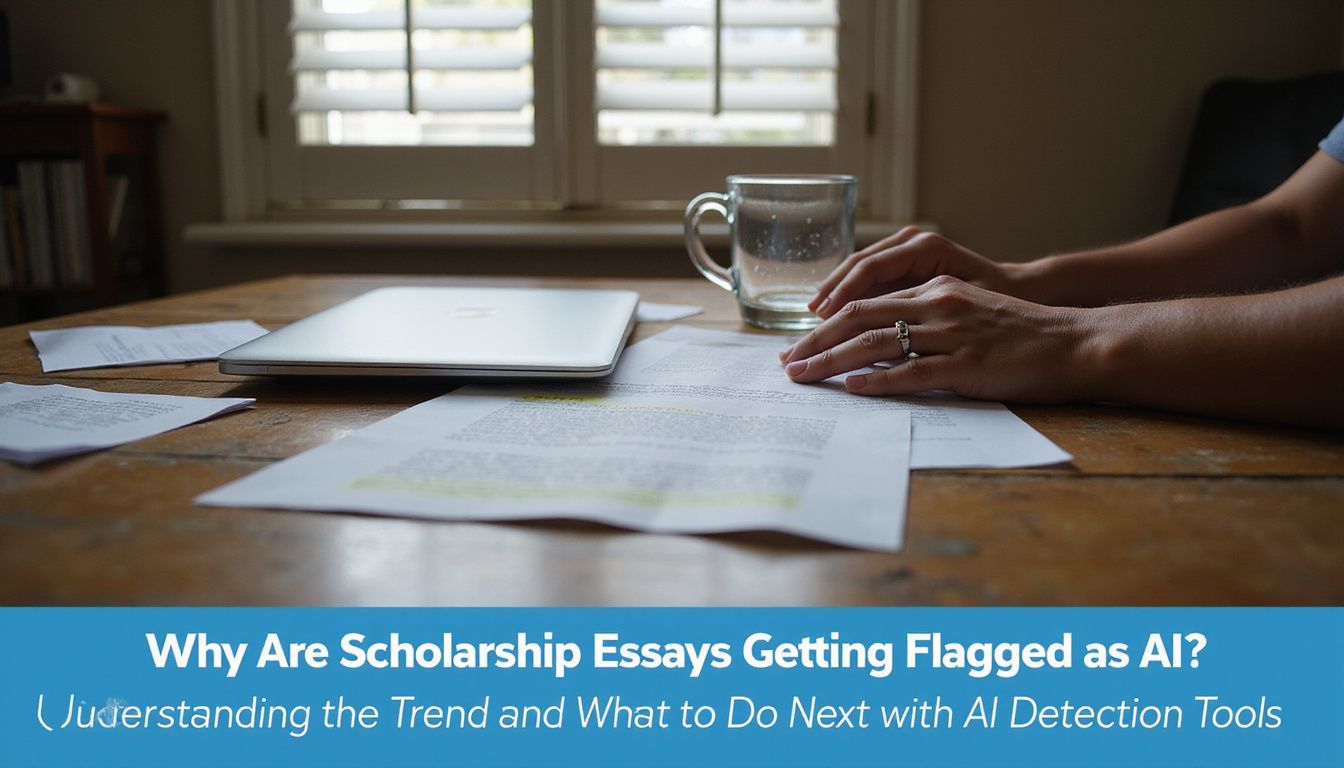Getting your scholarship essay flagged as AI can feel frustrating and unfair. With tools like Turnitin scanning for AI-generated content, even authentic writing can be questioned. This blog breaks down why these essays are getting tagged and how you can avoid it.
Keep reading to protect your hard work!
Key Takeaways
- Scholarship essays get flagged as AI due to patterns like repetitive phrases, generic examples, and overly polished styles. Tools like Turnitin detect these traits often found in automated content.
- Overusing AI tools for writing leads to essays lacking originality and personal voice. Committees value authentic stories over generic or robotic-sounding submissions.
- False positives are a problem with AI detection tools like Turnitin or GPTZero. Genuine work can be mislabeled due to rigid algorithms spotting common phrases or structured grammar.
- Save drafts, brainstorming notes, and revision history as proof of your essay’s authenticity. These records help counter false flags during reviews.
- Use AI responsibly by sticking to idea generation and grammar checks only. Avoid copying directly from tools like ChatGPT to maintain originality and avoid detection issues.

Why Scholarship Essays Are Being Flagged as AI
Scholarship essays are getting flagged because AI tools spot patterns that don’t feel human. Overusing artificial intelligence can make your writing lose its personal touch.
Increased use of AI in essay writing
AI tools like ChatGPT became popular fast. By 2023, nearly half of scholarship essays on Scholarships360 used AI-generated content. These tools make writing quicker and easier, but they leave traces that software can detect.
Patterns in formatting or tone often trigger AI detection tools. Essays written with help from artificial intelligence may lack human flaws, making them appear too polished or mechanical to be real.
Common patterns detected by AI tools
AI detection tools often flag essays with repetitive phrases and overused words. For instance, “Cornerstone” appears in 62% of essays marked as having more than 75% AI-generated content but only in 6% of those below that threshold.
Similarly, “Bedrock” is found in 20% of highly flagged essays compared to just 1% of others. These tools also identify clichés like “In the vibrant tapestry of human society,” which show up far more frequently in AI-written pieces.
Historical examples are another giveaway. References to Nazi Germany, North Korea, the Soviet Union, China, or the U.S. Civil Rights Movement pop up repeatedly in flagged texts. Such patterns suggest a generic approach that lacks personal voice or original thought.
Tools analyze these trends closely to detect generative AI usage and potential plagiarism during scholarship applications or admissions reviews.
Over-reliance on AI-generated content
Some students lean too much on AI-generated writing for scholarship applications. Essays written this way often lack originality and personal touch, which scholarship committees value most.
Generic vocabulary, repetitive phrases, and formulaic arguments make these essays stand out—for the wrong reasons. Starting an essay with “Dear _” also raises red flags; such openings were in 20% of essays flagged as 75% or more AI-written but only 5% of those below that threshold.
Using generative AI might seem like a shortcut, but it can backfire. Scholarship evaluators want authentic stories that reflect individuality. Essays relying heavily on machines risk being dismissed as robotic or insincere by admissions officers.
Students should aim to include personal narratives and ideas to avoid being labeled under academic dishonesty practices.
Issues with AI Detection Tools
AI detection tools mess up sometimes, flagging real essays as fake. They also give mixed results, leaving students confused and stressed.
False positives targeting authentic writing
AI detection tools often mislabel genuine writing as AI-generated due to rigid algorithms. These systems scan for patterns like overly formal language, repetitive phrasing, or lack of personal tone, which can appear in any polished essay.
Even authentic work gets flagged if it resembles common structures or styles found in generative AI outputs.
Vanderbilt University recently halted Turnitin’s AI detector after discovering a false positive rate of 1%. This error created tension among students and scholarship committees alike.
A single flag could unfairly harm college admissions chances or mar academic integrity records.
Inconsistent detection results
Different AI detection tools deliver mixed outcomes. Turnitin, GPTZero, OpenAI’s Classifier, and CopyLeaks often flag real writing as ai-generated content. A student could write their essay completely alone but still face false positives.
Such errors make scholarship committees doubt legitimate essays.
This inconsistency can create chaos for applicants who work hard to maintain academic integrity. For example, one tool might clear a Google Docs draft as clean while another labels it suspicious.
With no uniform standard in place, scholarship applications sometimes hang by a thread of uncertainty.
Limitations of current technology
AI detection tools often struggle to tell human writing from ai-generated content. False positives are common, making scholarship essays and other authentic writing seem like they were made by AI.
For instance, students using advanced grammar may get flagged unfairly because the software misreads their polished style.
These tools also lack consistency across different platforms. An essay might pass one detector but fail another, creating confusion for applicants and admissions officers alike. Their algorithms rely heavily on patterns, which can overlook nuance or creativity in a writer’s voice.
This gap leaves room for errors and frustration during scholarship applications.
Risks of Using AI for Scholarship Essays
Using AI for essays can backfire, leaving your work looking fake or plagiarized—stick around to find out why this matters.
Lack of originality and individuality
AI-generated essays often rely on basic vocabulary and predictable patterns. They use repetitive phrases, common historical examples, and overly structured arguments. This makes them feel robotic and lifeless.
Scholarship committees notice the lack of personal voice or emotional depth.
Such essays fail to show the writer’s unique perspective or personality. Admissions officers want heartfelt stories, not cookie-cutter answers. Failing to stand out can hurt your chances with scholarship applications.
Next, learn about the risks tied to using AI for these critical submissions.
Potential disqualification from applications
Some scholarships strictly ban AI-generated content. Scholarship committees want personal and authentic stories that reflect the writer’s voice, not something algorithmic. Using tools like ChatGPT to write entire essays can raise red flags during plagiarism detection.
Submitting flagged work might lead to disqualification. Admissions officers look for originality in scholarship applications. Essays must stand out and feel genuine to avoid suspicion or rejection altogether.
Ethical concerns
Relying on AI in scholarship essays raises serious ethical questions. Scholarship committees value academic integrity and expect genuine effort from applicants. Using AI-generated content can obscure the distinction between original thought and plagiarism.
Admissions officers might perceive excessive use of generative AI as dishonest, eroding trust.
Some students may justify AI use by citing heavy workloads or tight deadlines. But shortcuts like these diminish their individuality in essay prompts meant to highlight personal stories or values.
This misuse risks disqualification and damages long-term reputation, creating significant doubts about authenticity.
How to Use AI Responsibly for Essay Writing
AI can help sharpen your ideas and polish your drafts, but it shouldn’t write the essay for you. Keep its role small to keep your voice loud and clear.
Use AI for brainstorming and idea generation
AI offers a quick way to spark creative ideas for essay prompts. For example, students can use it to brainstorm responses to questions like, “Why do you deserve this scholarship?” or “What are your academic goals?” Generative AI tools suggest angles and guide thinking without replacing personal input.
This makes tackling tough topics easier while keeping the writing process personal.
Using AI as a brainstorming partner helps highlight different perspectives. It also provides guiding questions for essays about challenges or achievements. Writers still control the direction of their answers, ensuring originality in every response.
The key is treating AI-generated content as inspiration, not finished work.
Employ AI for grammar and clarity checks only
AI works best as a helper, not the main writer. Use it to check grammar mistakes or improve sentence flow after you write your essay. This keeps your work original and avoids detection issues with AI detection tools like Turnitin or GPTZero.
Relying too much on generative AI can lead to flagged content, making scholarship applications risky. Proofreading helps polish your writing without replacing your voice. For clarity checks, tools can suggest smoother ways to phrase ideas but don’t rewrite large sections for you.
Next, let’s discuss how copying from AI-generated content directly causes problems.
Avoid copying AI-generated content directly
Copying AI-generated content directly can raise red flags. Tools like ChatGPT create text that often lacks personal style or unique voice, making it easier for ai detection tools to flag.
Scholarship committees value originality and individuality. Using repetitive phrases or generic examples from generative AI can make your essay feel robotic instead of authentic.
A student from Kentucky showed how a true story connects with evaluators more than polished but impersonal language. Instead of pasting an entire draft from a computer program, write in your voice.
Use AI sparingly for clarity checks or brainstorming ideas only; this keeps academic integrity intact while avoiding plagiarism detection risks by scholarship applications systems.
Steps to Prove Your Essay Was Authored by You
Save all your drafts and show your writing journey. Share notes or ideas to back up how you built your essay bit by bit.
Preserve drafts and revision history
Keep every draft of your essay. Save early versions, edits, and each tweak you make. They show your writing process and prove your work is genuine. Scholarship committees may ask for this to verify authenticity.
Store files with clear names like “Essay_Draft1” or use tools like Google Docs to track changes automatically. These records can help counter false positives from AI detection tools or accusations of academic fraud.
Provide brainstorming notes
Jot down all your raw ideas before starting the essay. Use a notebook or word processor to record thoughts, arguments, or examples related to the prompt. Keep these notes organized but simple.
For example, if an essay asks about overcoming challenges, list specific events like moving schools or managing part-time jobs.
Save every stage of this process. Even messy scribbles can prove authenticity later. Scholarship committees may ask for proof of originality; brainstorming notes help connect dots between drafts and final essays.
Showing how your ideas grew makes it clear there’s no AI-generated content hiding in plain sight.
Submit additional writing samples
Show your authentic writing style by sharing extra essays or projects. These samples can help scholarship committees compare them with the submitted essay. They may check for consistent tone, grammar, and vocabulary use.
Including brainstorming notes or earlier drafts can back up your claim of originality. Videos or portfolios could also serve as proof of effort and creativity in scholarship applications.
Is It Safe to Use ChatGPT to Draft Scholarship Essays?
Using ChatGPT for scholarship essays comes with risks. Scholarship committees and admissions officers often use AI detection tools to spot automated content. If flagged, your application could face rejection, leading to disqualification from consideration.
AI-generated writing lacks personal touch, which essay prompts require. Schools like the University of Southern California stress academic integrity during reviews. Over-reliance on generative AI may raise ethical concerns too.
Explore safer options in the next steps below!
Conclusion
Scholarship essays flagged as AI raise big questions about fairness and technology. Students must stand out with genuine, personal stories while avoiding overusing tools like ChatGPT.
Save drafts, take notes, and lean on your creativity to prove authenticity. Stay smart with tech, but let your voice lead the way.
For more insights on this topic, check out our article on whether it’s safe to use ChatGPT for drafting scholarship essays.




